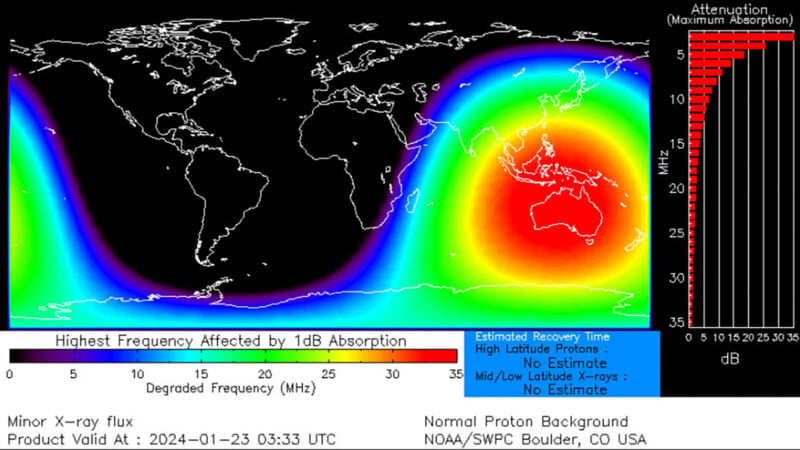
Two powerful solar flares exploded nearly simultaneously on the Sun earlier this week, creating a spectacular and exceptionally rare sight.
At about 10:30 PM ET on January 22, a pair of solar flares erupted from sunspots AR3559 and AR3561 at nearly the same time. The two flares occurred around 310,000 miles (half a million kilometers) apart on the Sun’s surface.

Per Spaceweather, the dual explosions an intensity of M5.1, (https://www.spaceweather.com/glossary/flareclasses.html) flares typically strong enough to trigger brief radio blackouts at the Earth’s poles. In this case, the flares caused a 30-minute radio blackout above parts of Australia and Indonesia.
“Today’s sympathetic flare caused a shortwave radio blackout over Australia and Indonesia. Ham radio operators and mariners may have noticed a loss of signal at frequencies below 30 MHz for as much as 30 minutes after the flare’s peak,” Spaceweather explains.

The flare, indicative of the Sun’s ever-more-turbulent and active solar cycle, ultimately did not deliver much aurora activity. The planetary K (Kp) index peaked shy of Kp 4 in the early hours of January 24 (GMT-0), which can deliver minor auroral activity at very high latitudes.
Multiple solar flares in quick succession can sometimes instigate “cannibal coronal mass ejections (CMEs),” which can create powerful solar storms and, thus, beautiful auroral displays. However, sympathetic solar flares like those seen earlier this week are different, as Space explains.
“In the past, researchers assumed that a sympathetic flare was just a freak coincidence. But a 2002 study revealed that the flare pairs are actually linked together — or more accurately, their sunspots are linked together by massive, invisible magnetic field loops that arc around the sun. Therefore, the flares can be considered as two parts of a single explosion,” writes Space.
“Sympathetic flares are a pair of flares that occur almost simultaneously in different active regions, not by chance, but because of some physical connection,” the referenced study, Statistical Evidence for Symathetic Flares, explains. The team studied 48 sets of simultaneous flares, finding significant evidence that, in some cases, a physical connection between simultaneous flares makes them sympathetic rather than coincidental.
Sympathetic flares can be separated by as much as half an hour. However, in the recent case, it appears that based on footage captured by NASA’s Solar Dynamics Observatory (SDO), the two solar flares were separated by a few minutes, at most, and possibly just seconds. The images are timestamped, but there is not enough information available to nail down precise flare timing.
Space notes that sympathetic flares are “extremely rare,” although they do occur at a higher frequency during solar maximum. A 2022 study, Sympathetic solar flare: characteristics and homogeneities, considered 2,204 sympathetic flares detected from 1975 through 2017 from a pool of 77,604 total flares, concluding, “The frequency of the occurrence of sympathetic flares depends on the solar cycle activity. The number of sympathetic solar flares increases with the increase in solar activity and decreases as solar activity decreases.”
Although the recent sympathetic solar flares did not produce much by way of geomagnetic storm activity in Earth’s atmosphere, photographers should continually monitor Spaceweather for reports of geomagnetic activity and possible auroras. Solar activity has been ramping up in the past year or so, and there should be plenty of chances for great aurora photos. In fact, there’s a chance for activity tomorrow night.
